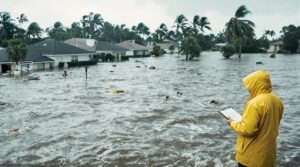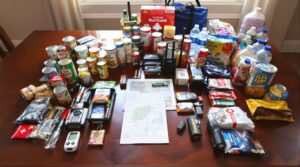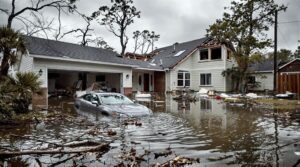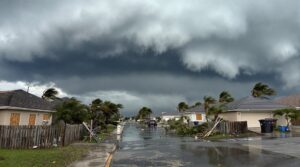Ten essential hurricane safety measures include installing storm shutters, preparing an emergency kit with water and supplies, creating a family communication plan, monitoring evacuation orders, identifying safe shelter locations, securing outdoor items, maintaining emergency contact information, stockpiling nonperishable food, gathering medical supplies, and keeping battery-powered devices charged. Understanding these fundamental precautions marks the beginning of thorough hurricane preparedness that can protect lives and property during severe weather events. Additionally, it’s crucial to stay informed about weather updates and to know how to prepare for hurricanes as they approach your area. Engaging in community preparedness programs can further enhance your readiness and help foster a supportive network during emergencies. By taking proactive steps and regularly reviewing your preparedness plans, you can significantly reduce risks and ensure that you and your loved ones remain safe during a hurricane.
Key Takeaways
- Stay informed through battery-powered NOAA weather radios and official updates to monitor storm developments and evacuation orders.
- Stock emergency supplies including one gallon of water per person daily, nonperishable food, medications, and first aid materials.
- Secure your home by installing storm shutters, reinforcing doors, and moving outdoor furniture inside before the hurricane arrives.
- Avoid going outdoors during the storm and stay away from windows, using interior rooms for shelter.
- Use text messages instead of phone calls to communicate with family, and have a clear evacuation plan with designated meeting points.
Securing Your Home Before the Storm
Securing a home before a hurricane requires multiple critical preparatory steps to minimize potential damage and protect occupants.
Essential home security measures include installing permanent storm shutters or pre-cutting 5/8" marine plywood for windows, as window tape provides no protection against breakage. Doors and garage entrances need reinforcement with additional clips or straps to withstand high winds.
Storm preparation extends to the roof and surrounding property. Homeowners should inspect and repair any loose shingles, guarantee gutters are firmly attached, and clear all drainage systems of debris. Following a detailed emergency preparedness plan helps ensure no critical steps are missed.
The removal of weak trees and overhanging limbs prevents potential damage during high winds. All outdoor furniture, decorations, and waste containers must be brought inside or securely stored.
Utility safety requires knowing how to shut off water, electricity, and gas. Installing a backup generator and testing drainage systems complete the essential preparatory measures.
Documentation of possessions and important papers should be secured in a safe location.
Essential Emergency Supply Kit Components
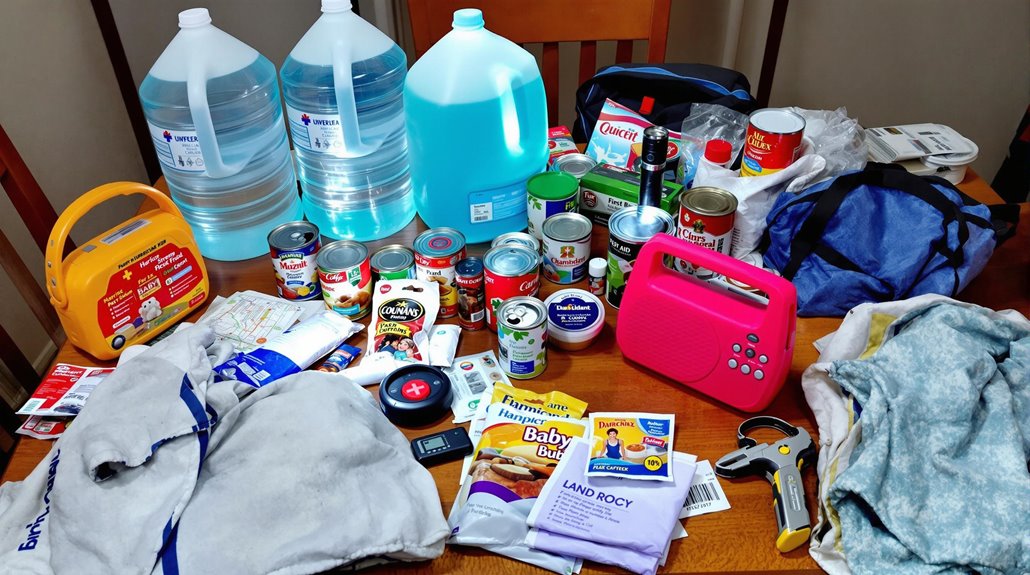
A thorough hurricane emergency supply kit requires specific components to sustain individuals and families during both evacuation scenarios and home-based sheltering.
The emergency supply checklist prioritizes water allocation at one gallon per person daily, with a three-day supply for evacuation and two-week supply for home sheltering, alongside nonperishable food in similar quantities. Store supplies in a cool, dry place to maintain their quality and effectiveness.
The essential items guide emphasizes critical categories: lighting and communication tools, including flashlights, batteries, and NOAA weather radios; health and hygiene supplies, featuring first aid materials and a week's worth of medications; and family-specific needs.
Communication preparedness requires cell phones with backup power sources, extra cash, and physical maps. Families must account for specialized needs, including baby supplies, pet care items, and comfort provisions such as extra clothing and blankets.
Additional practical items include manual can openers, cooking equipment, and multipurpose tools for various emergency scenarios.
Creating a Family Communication Plan
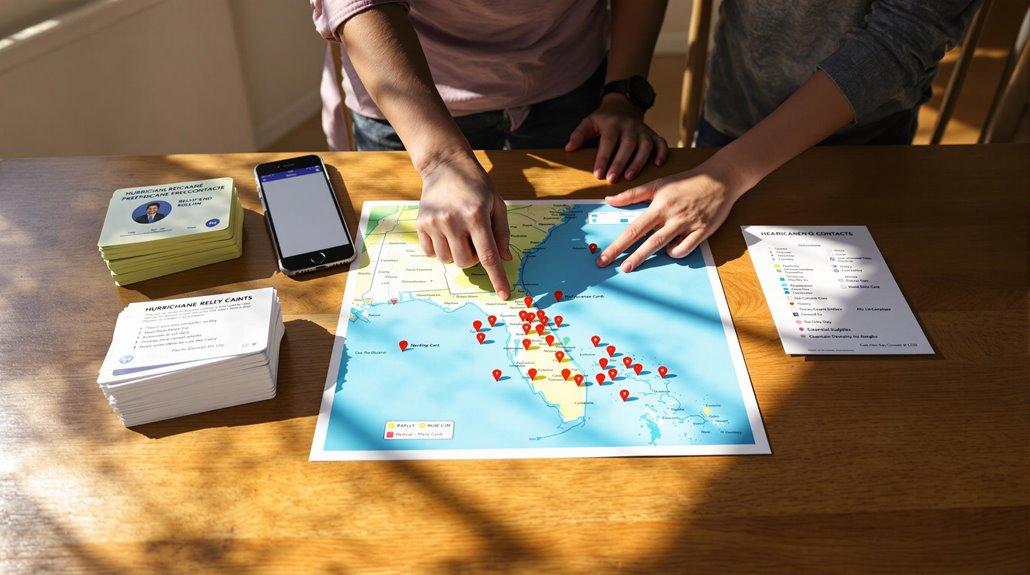
When establishing a family communication plan for hurricanes, the first critical step is designating specific rally points where family members can reunite if separated during evacuation or emergency conditions.
These predetermined meeting locations should include both a nearby spot, such as a neighbor's house or local landmark, and a secondary location outside the immediate area in case the neighborhood becomes inaccessible.
Once rally points are established, families should create and distribute emergency contact cards containing essential phone numbers, meeting locations, and an out-of-area contact person who can coordinate communication between separated family members. Text messaging is recommended over phone calls to avoid network congestion during emergency situations.
Set Rally Points First
Preparation is the foundation of an effective hurricane evacuation plan, and establishing rally points should be the first priority when creating a family communication strategy.
Rally point preparation begins with identifying multiple safe gathering locations at different distances from home, including a neighborhood spot for immediate assemblies and an out-of-town location for extensive evacuations. Every family member should store these meeting locations and have ICE contact details readily available.
Meeting location selection requires careful consideration of accessibility, safety, and visibility. Families should designate primary and backup meeting spots, accounting for various emergency scenarios.
The chosen locations must be familiar to all family members and easily reachable through multiple routes. Emergency shelters should be identified as contingency gathering points, and all family members must know the safe routes to reach each designated location.
This systematic approach guarantees everyone knows where to gather when communication becomes difficult.
Share Emergency Contact Information
Building an effective hurricane response requires a thorough family communication plan centered on emergency contact information. Families should compile detailed lists of emergency contacts including medical providers, utility companies, and an out-of-town contact to serve as a central point of communication during crisis situations.
The plan should establish multiple communication methods, incorporating both traditional and digital approaches. Accessing the FEMA mobile app can provide critical updates about emergency shelters and weather conditions during a hurricane. Families need to create physical copies of contact information for distribution to all members, store digital versions online for accessibility, and maintain wallet-sized cards for immediate reference.
Regular practice sessions guarantee all household members understand the protocols and can execute them effectively during emergencies. The plan should also include registration for local emergency alerts and designation of text messaging as an alternative when phone calls become unreliable.
Understanding Evacuation Orders and Routes

During a hurricane threat, understanding evacuation orders and routes can mean the difference between safety and peril. Local officials may issue either mandatory evacuations, which legally require residents to leave, or voluntary evacuations, which strongly recommend departure but are not enforceable. Proper evacuation planning and order compliance are essential for protecting lives. Having a detailed hurricane evacuation checklist ensures no critical items or documents are forgotten during a stressful departure.
Residents should monitor local news and emergency services for evacuation announcements, as timing is critical. When orders are issued, individuals should depart early using designated evacuation routes, even if traffic is heavy. Alternative routes may be closed or unsafe.
Prior preparation, including securing fuel, making accommodation arrangements, and having a disaster supply kit ready, enables swift departure when needed.
The decision to evacuate considers multiple factors, including the hurricane's size, speed, projected path, and an area's vulnerability to storm surge and flooding. Officials issue these orders to guarantee residents have adequate time to reach safety before conditions deteriorate.
Safe Shelter Options During a Hurricane
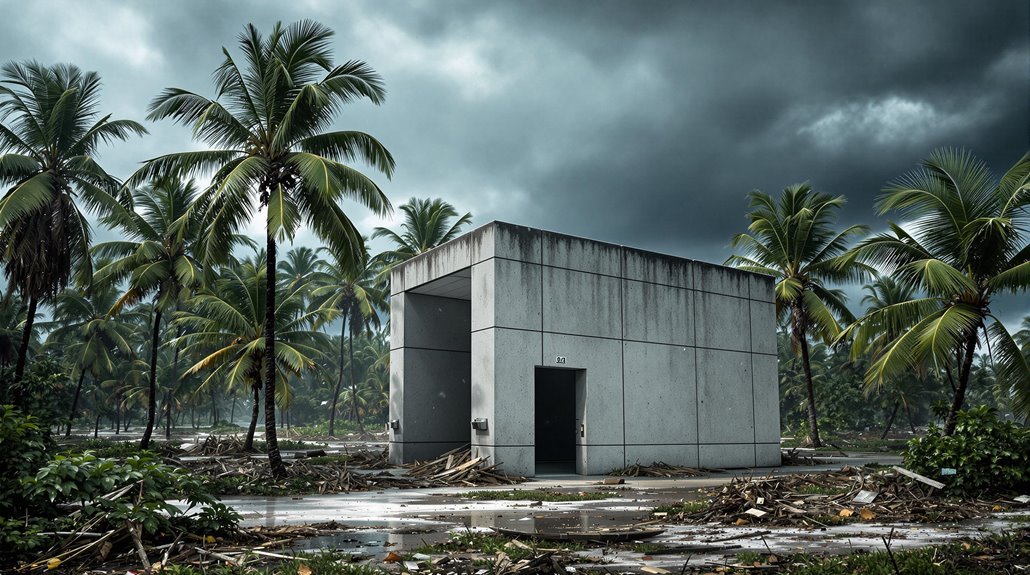
Identifying secure indoor locations during a hurricane requires careful evaluation of both above-ground and below-ground shelter options that meet FEMA 361 and ICC-500 safety guidelines.
Properly reinforced full basements with concrete roof slabs provide superior protection, while above-ground shelters must feature steel-reinforced concrete floors and specialized anchoring systems. Well-built storm shelters can accommodate at least 10 people along with their pets during severe weather conditions.
Home protection can be enhanced through professionally installed in-residence shelters or commercially manufactured units designed to withstand Category 5 hurricane conditions.
Finding Secure Indoor Locations
When facing a hurricane's approach, securing a safe indoor location becomes a critical priority for individuals and families. The strongest areas of a building offer ideal hurricane safety, particularly rooms without windows. Above-ground and underground shelters provide enhanced protection through reinforced construction and specialized anchoring systems. Emergency radio communication is essential for monitoring conditions and receiving updates while sheltering.
| Location Type | Key Features | Safety Considerations |
|---|---|---|
| Above-Ground Shelter | Reinforced Steel | Away from Windows |
| Underground Shelter | Debris Protection | Proper Ventilation |
| Interior Room | Strong Walls | No External Exposure |
| Community Center | Basic Amenities | Professional Staff |
| School Building | Multiple Spaces | Designated Areas |
Those unable to access private shelters can utilize public facilities, which typically offer essential services and real-time availability updates. These locations maintain thorough safety protocols and emergency communication systems for continuous monitoring of weather conditions.
Strengthen Your Home Protection
Proper home protection measures greatly reduce the risk of hurricane-related damage and enhance occupant safety during severe weather events.
Essential structural upgrades include installing impact-resistant windows, reinforcing garage doors, and securing roof components. Applying three roofing cement dabs under shingle tabs provides crucial stability during high winds. Homeowners should seal exterior openings with high-quality caulk and guarantee foundation integrity by addressing cracks promptly.
Storm shutters or plywood panels provide vital window protection, while hurricane-rated doors made of fiberglass, steel, or aluminum strengthen entry points.
Regular maintenance includes trimming trees, securing loose outdoor items, and clearing gutters to prevent water accumulation. Properly fastened soffits and approved exterior fixtures further fortify the structure against high winds.
Homeowners should verify their home insurance policies cover hurricane damage and comply with local building codes for maximum protection.
Managing Power Outages and Utilities
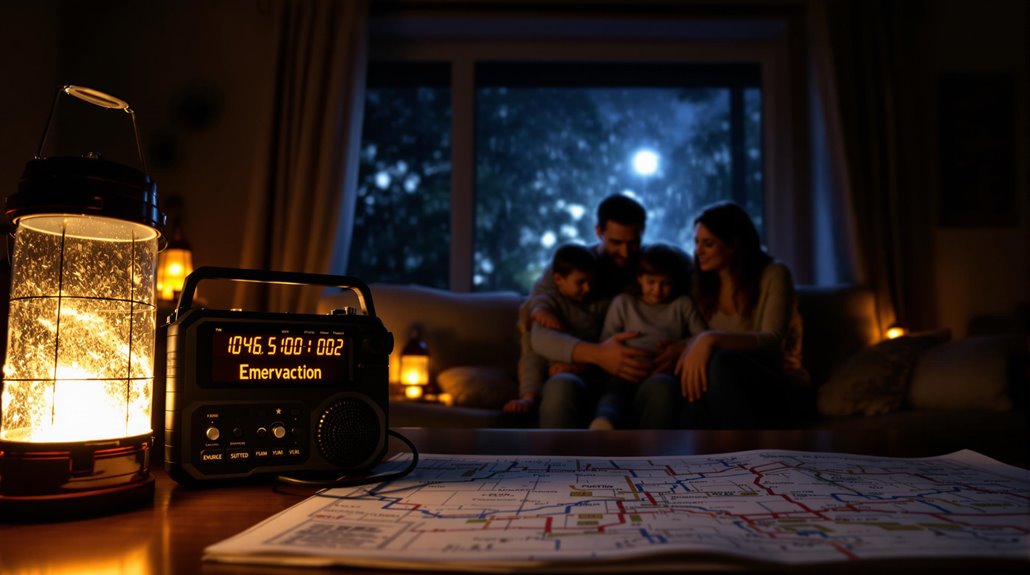
Managing power outages effectively during a hurricane requires thorough preparation and vigilant monitoring of utility systems. Outage preparedness includes assembling emergency kits, installing surge protectors, and establishing reliable communication methods. Residents should stay informed about utility communication through battery-powered radios and official updates while avoiding dangerous conditions like downed power lines. Modern prediction systems can now forecast outages with 98% accuracy three days before a hurricane makes landfall.
Utility companies employ sophisticated strategies to manage outages efficiently:
- Smart grid technologies and outage management systems track restoration progress
- Drones and advanced equipment assess damage in hard-to-reach areas
- Pre-positioned response teams expedite power restoration efforts
During outages, safety remains paramount. Residents should remain indoors, avoid flooded areas that may conceal live wires, and follow emergency instructions from utility providers.
Data-driven forecasting helps utilities anticipate outage locations and deploy resources effectively, while real-time monitoring guarantees systematic restoration of power to affected areas. This coordinated approach between utilities and residents maximizes safety and minimizes disruption during hurricane events.
Protecting Your Family From Flood Dangers
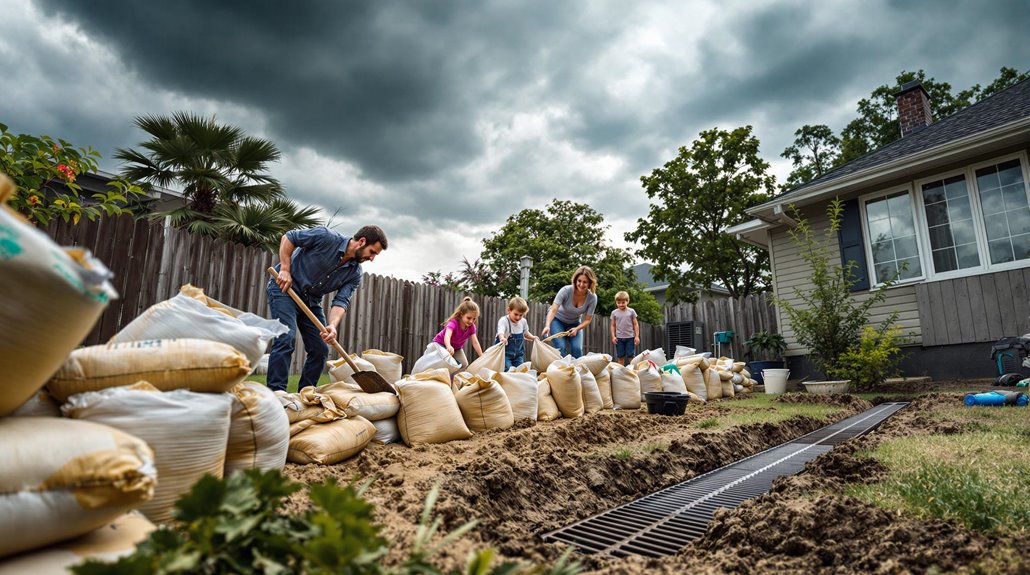
Beyond power outages, flooding presents one of the most immediate threats to families during hurricanes. To protect against flood risks, homeowners should implement both structural and preventive measures.
Installing French drains and swales helps direct water away from foundations, while waterproof sealants and coatings provide additional protection for walls and windows.
Creating effective water barriers requires a multi-layered approach. Families should invest in flood protection products such as sandbags or commercial flood barriers to prevent water intrusion.
Installing proper drainage systems and maintaining clear gutters and downspouts greatly reduces flooding potential around the home. Additionally, securing flood insurance coverage offers financial protection against water damage not typically covered by standard homeowner policies.
Families should develop and practice evacuation plans with multiple escape routes, maintain emergency supplies in waterproof containers, and stay informed through battery-powered radios during severe weather events.
These preparations help guarantee swift action when flood dangers arise.
Critical Do's and Don'ts During the Hurricane

During a hurricane emergency, clear decision-making and adherence to safety protocols can mean the difference between life and death. Following established storm safety guidelines is vital for protecting lives and property. Residents should monitor emergency broadcasts via battery-powered radios and execute their hurricane preparedness tips immediately when instructed.
- Turn off all main utilities, including power, water, and gas, to prevent secondary hazards.
- Seek appropriate shelter in interior rooms on the lowest floor, away from windows and doors.
- Never attempt to drive, walk, or swim through flood waters under any circumstances.
Safety measures include using flashlights instead of candles to prevent fires, keeping essential documents in waterproof containers, and maintaining access to emergency supplies.
If flooding occurs, occupants should move to higher levels of buildings while avoiding closed attics. Following evacuation orders promptly and staying informed through official channels remains fundamental for survival during hurricane conditions.
Accessing Emergency Services and Support
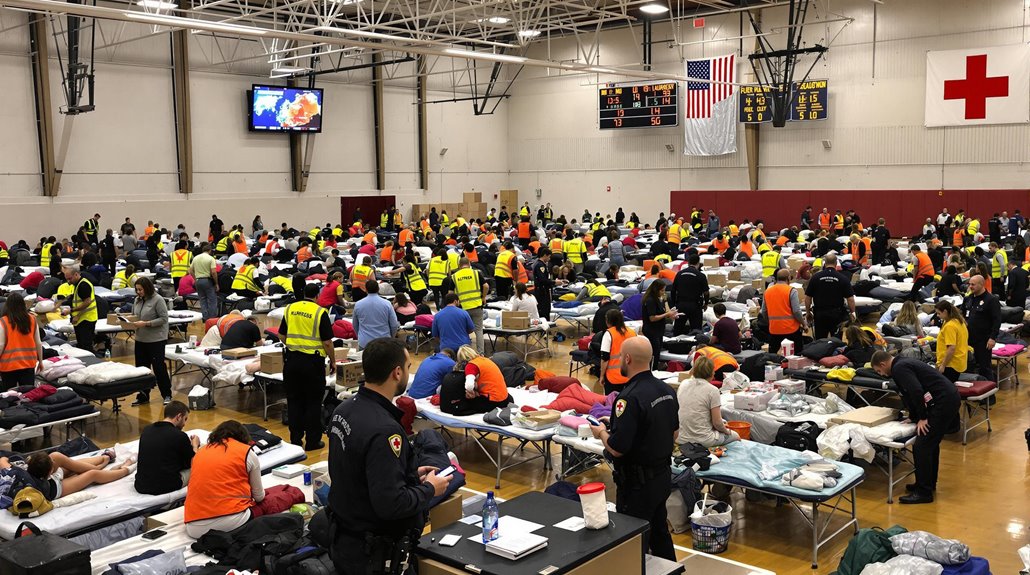
During a hurricane emergency, residents should immediately contact their local emergency management offices and support centers for evacuation instructions and community-specific guidance.
The Emergency Alert System (EAS) and Wireless Emergency Alerts (WEA) provide critical real-time information about storm conditions and safety directives.
Those requiring medical assistance should call 911 for emergencies or locate the nearest Red Cross shelter, which offers essential health services and support during disasters.
Contact Local Support Centers
Several essential emergency contact numbers and support centers are available to provide critical assistance during hurricane emergencies.
The State Assistance Information Line (800-342-3557) offers extensive local resources in multiple languages, while community support can be accessed through 2-1-1 for various services.
- FEMA's application hotline (800-621-3362) and DisasterAssistance.gov provide disaster assistance registration.
- The Salvation Army (800-725-2769) and American Red Cross (800-733-2767) offer emergency supplies and shelter information.
- Multi-Agency Resource Centers (MARCs) provide centralized support for housing, food, and legal services.
Residents can access additional support through Hope Florida's website for household goods and repairs, while specialized assistance for farmers is available through farmers.gov.
Free legal services can be obtained via the Disaster Legal Services hotline.
Emergency Alert Systems
The Emergency Alert System (EAS) operates as a nationwide public warning network, connecting federal, state, and local authorities with the public during emergencies.
Alert dissemination occurs through multiple channels, including radio, television, cable systems, and wireless devices, guaranteeing thorough coverage during severe weather events and other emergencies.
As part of emergency preparedness, the system relies on authorized agencies utilizing FEMA's Integrated Public Alert and Warning System to create and distribute critical messages.
The NOAA Weather Radio All Hazards network provides additional warning information, while secure SSL connections and AES encryption protect message integrity.
The system's fault-tolerant design guarantees continuous operation even during partial outages, making it a reliable source for weather alerts, AMBER alerts, and civil emergency messages in affected communities.
Get Medical Assistance Fast
Swift access to medical assistance remains critical during hurricane emergencies through pre-positioned resources and coordinated response systems. Emergency response teams utilize pre-storm staging of ambulances and medical supplies while maintaining direct communication with hospitals through satellite systems when traditional networks fail.
- Mobile medical units deploy to hard-hit areas, providing critical care when local facilities reach capacity.
- Medical triage protocols guarantee efficient patient assessment and resource allocation based on injury severity.
- Field treatment sites and mobile clinics activate to serve displaced populations and those requiring immediate care.
Healthcare providers coordinate with public health officials to maintain continuous medical support through mobile clinics and specialized care services.
These integrated systems guarantee essential medical services remain accessible during hurricanes, with ongoing monitoring and support for affected populations throughout the emergency period.
Recovery Steps After the Storm Passes
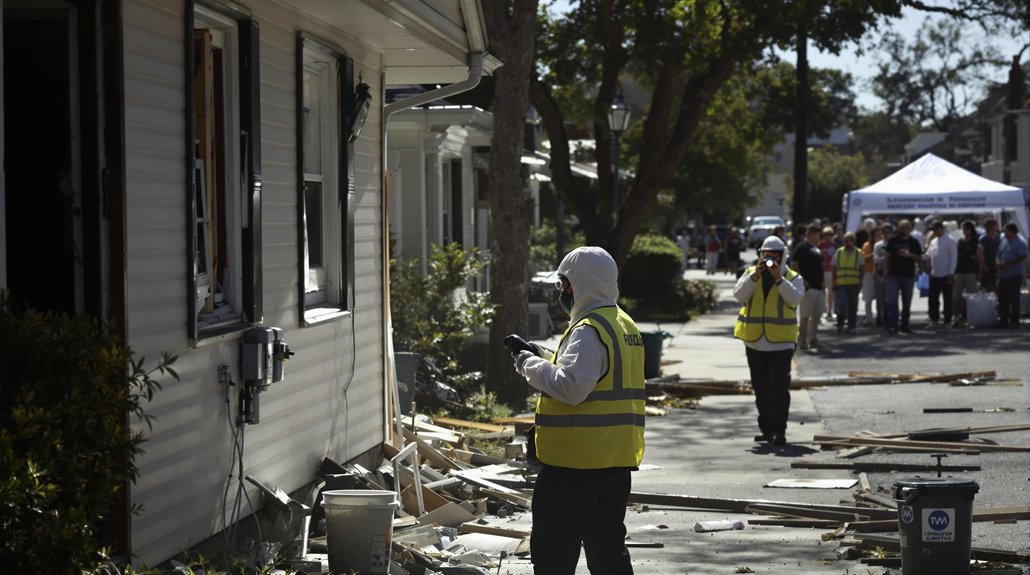
Once local authorities declare the area safe, residents must take systematic steps to assess damage and begin the recovery process. The initial post-storm evaluation requires residents to carry proper identification and exercise extreme caution when approaching their property, staying alert for hazards like downed power lines, gas leaks, and displaced wildlife.
A thorough disaster recovery plan includes documenting all damages through photographs and detailed inventories for insurance purposes. Residents should immediately implement temporary repairs, such as boarding broken windows and covering roof damage, to prevent further deterioration of property.
The proper shutdown of utilities remains essential until professional inspection confirms their safety. Individuals must also prioritize their physical and mental well-being throughout the recovery period. This includes seeking prompt medical attention for injuries and utilizing available community resources for emotional support.
Maintaining detailed records of all recovery-related expenses and working with licensed contractors helps guarantee a structured and legitimate restoration process.
About The Public Claims Adjusters Network (PCAN)

During challenging insurance claim processes following hurricane damage, experienced public claims adjusters serve as valuable advocates for policyholders. These licensed professionals assess property damage, document losses, and negotiate with insurance companies to guarantee fair settlements. The Public Claims Adjusters Network (PCAN) connects homeowners with qualified adjusters who understand the complexities of hurricane-related claims.
- Public adjusters examine insurance policies to determine coverage scope and evaluate repair costs.
- They provide thorough documentation of damages and communicate professionally with insurers.
- Professional adjusters handle all aspects of the claims process while maximizing potential compensation.
PCAN members must maintain proper licensing and follow strict regulations established by state insurance departments. These requirements include approved contracts, transparent fee structures, and proper notification to insurance companies.
Through their expertise in policy interpretation and damage assessment, public adjusters help streamline the recovery process while guaranteeing policyholders receive appropriate compensation for their hurricane-related losses.
Frequently Asked Questions
How Do I Protect My Pets if I Need to Evacuate?
Pet evacuation requires advance preparation and vital emergency supplies.
Owners should assemble a kit containing three days of food, water, medications, and medical records in waterproof containers.
Securing pet carriers, extra leashes, and identification tags is essential.
Pre-identifying pet-friendly shelters or hotels along evacuation routes and making reservations guarantees safe accommodation.
Coordinating with neighbors or relatives provides backup care options if needed.
What Should I Do if I Run Out of Fuel During Evacuation?
If fuel runs out during evacuation, one should immediately pull over to a safe location away from traffic.
Contact emergency services or local authorities for assistance.
Keep emergency supplies in the vehicle, including a charged phone, water, and non-perishable food.
Consider fuel alternatives like requesting help from other evacuees or using ride-sharing services.
Monitor emergency broadcasts for information about nearby fuel availability or rescue services.
Can I Drink Tap Water During and After a Hurricane?
When it comes to tap water safety, it's better to be safe than sorry.
During and after a hurricane, all tap water should be considered unsafe until local authorities confirm otherwise.
For emergency drinking needs, water should be boiled for at least one minute to kill pathogens.
Alternative treatments include household chlorine bleach, though this won't remove chemical contaminants.
Testing is essential before resuming regular tap water consumption.
When Is It Safe to Return Home After Evacuating?
Residents should only return home after official evacuation guidelines are lifted and authorities declare safe reentry.
Local emergency management officials will assess hazards like flooding, downed power lines, and structural damage before permitting return.
Monitoring local news and emergency broadcasts provides vital updates on conditions.
Upon return, individuals must carefully inspect their property for damage, watching for gas leaks, contaminated water, and compromised structures.
How Can I Protect Important Documents From Water Damage?
Important documents require proper document storage using multi-layered protection methods.
Waterproof containers, including specially rated safes and sealed plastic bags, provide essential protection against moisture damage. Storing documents in elevated locations and using silica gel packets helps prevent deterioration.
Creating digital backups and storing them in secure cloud platforms offers additional security. Climate-controlled storage units provide ideal preservation conditions for physical documents.
References
- https://www.mass.gov/info-details/hurricane-safety-tips
- https://www.floridadisaster.org/planprepare/make-an-evacuation-plan/
- https://cajunnavy2016.org/preparedness/stay-safe-during-hurricane-season/
- https://www.marforcom.marines.mil/Portals/36/Safety_Tips/MFC_2024_Hurricane_Prep_Safety_Tips.pdf
- https://shrewsburyma.gov/211/Evacuation-Steps-for-a-Hurricane
- https://www.highlandhomes.org/blog/blog-detail/hurricane-preparedness-create-your-florida-hurricane-checklist-994
- https://www.fema.gov/blog/hurricane-safety-tips-learn-what-do-during-and-after-hurricane
- https://americanplatinumpcic.com/how-to-prepare-house-for-hurricane/
- https://www.constellation.com/energy-101/hurricane-safety-tips.html
- https://www.miamidade.gov/global/emergency/hurricane/kits-checklists.page



